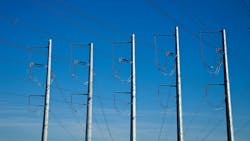The Past, Present, and Future of Utility Structures
Back in 2021, I had the chance to attend the 100th anniversary celebration of Hughes Brothers, a manufacturer in Seward, Nebraska, known for its wood and steel structures used in electric utility systems. The event brought together manufacturers’ reps, clients, and editors from T&D World for a facility tour, dinner with employees, and a field demonstration. One of the day’s highlights was a live structure test simulating extreme wind loads on an H-frame wood pole reinforced with a steel X-brace. As the wind speed simulation reached 300 mph, the structure finally buckled and collapsed — a dramatic and memorable sight. It was the kind of firsthand field experience that gives editors valuable insight into how these structures perform under stress.
That day also sparked my deeper interest in the ongoing industry debate around wood vs. steel vs. composite structures. Some of the Hughes Brothers representatives were firmly in the “Team Wood” camp. But as I began researching the history and evolution of utility poles, I found a fascinating progression of materials and innovations. About a decade ago, T&D World technical editor Gene Wolf wrote a feature titled “The Grid Takes Shape,” outlining how each advancement in structure design — often driven by increased voltage needs — triggered a domino effect of new challenges and solutions. For example, higher voltages required better insulators, which led to the development of stackable disc insulators and longer insulator strings. That, in turn, required stronger hardware and taller poles, which put pressure on wood supply and sparked the exploration of alternative materials.
Steel and concrete structures entered the mix to meet those evolving demands. Steel lattice towers became popular for their strength and compact footprint, though they were labor-intensive to assemble. About 50 years ago, labor-saving tubular steel poles gained favor for being easier to install and lighter than wood — ideal for urban settings and increasingly high-voltage lines like 500 kV and beyond. Concrete poles, though older than many realize, have also evolved significantly. They were first used in Europe for telegraph lines in the 1850s and improved dramatically with the introduction of spun-cast and later pre-stressed designs, which offered both strength and flexibility. Eventually, manufacturers combined these techniques to balance durability with weight, creating customizable poles tailored to each utility’s needs.
Hybrid and composite structures have taken things even further. Companies like Meyer Utility Structures developed poles that combine a strong lattice base with a tubular top for easier assembly and reduced right-of-way needs. Valmont created a steel-concrete hybrid with a concrete base below ground and a steel top above, optimizing durability and performance. Even wood structures evolved — Laminated Wood Systems now uses bonding techniques and synthetic resins to transform lower-grade or recycled wood into stronger, long-lasting poles. The demonstration I witnessed at Hughes Brothers, with steel components reinforcing a traditional wood structure, exemplified this evolution in action.
Composite materials opened an entirely new design frontier. The first fiberglass poles were tested in the 1960s in harsh coastal environments like Maui to combat corrosion issues. Though initially vulnerable to UV exposure, new coatings solved that problem. Over time, manufacturers adopted advanced thermosetting and polyurethane resins to create highly durable, modular pole systems. These allow utilities to mix and match sizes, lengths, and diameters to meet specific project needs — delivering unprecedented flexibility.
Our cover story this month spotlights Ameren Corp.’s approach to hardening its grid against extreme weather. By strategically incorporating fiber-reinforced polymer poles into its wooden sub-transmission systems, Ameren has significantly reduced cascading outages, boosting reliability and customer satisfaction. As Gene once wrote, “Utility engineers have always wanted more choices and selections. They need to modify, change, and improve things like they need to breathe.” That mindset is more critical than ever today, as the industry leans on grid-enhancing technologies to extend the lifespan and capacity of existing infrastructure, especially with new transmission builds lagging behind rising demand.
So, whether you’re Team Wood, Team Steel, or Team Composite, it’s less about loyalty to a material and more about selecting the right tool for the job. Utility structure design has matured well beyond one-size-fits-all, and there are pros and cons to all of them. With today’s range of materials and hybrid innovations, utilities have more choices than ever to meet their performance, budget, and environmental needs.
Read More
About the Author
Nikki Chandler
Group Editorial Director, Energy
Nikki is Group Editorial Director of the Endeavor Business Media Energy group that includes T&D World, EnergyTech and Microgrid Knowledge media brands. She has 29 years of experience as an award-winning business-to-business editor, with 24 years of it covering the electric utility industry. She started out as an editorial intern with T&D World while finishing her degree, then joined Mobile Radio Technology and RF Design magazines. She returned to T&D World as an online editor in 2002. She has contributed to several publications over the past 25 years, including Waste Age, Wireless Review, Power Electronics Technology, and Arkansas Times. She graduated Phi Beta Kappa with a B.S. in journalism from the University of Kansas.



